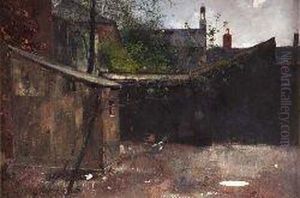John Quinton Pringle Paintings
John Quinton Pringle was a Scottish painter who is best known for his intimate depictions of domestic and urban scenes in and around Glasgow. Born on January 19, 1864, in the city of Auchterarder, Scotland, Pringle moved to Glasgow at a young age. He initially trained as an optician, a profession he continued to practice throughout his life, which provided him with a stable income and allowed him to pursue painting without financial pressures.
Pringle received his formal art education at the Glasgow School of Art, where he studied in the evenings while maintaining his daytime job as an optician. Despite his limited time, he quickly developed a distinctive style influenced by the French Impressionists and the Hague School. Pringle's work was characterized by a muted palette, a focus on the effects of light, and a sensitive rendering of his subjects, which often included the city's poorer inhabitants and their environs.
Unlike many of his contemporaries who were associated with the Glasgow Boys—a group of artists known for their modern painting techniques—Pringle largely worked in isolation and did not seek widespread recognition. His paintings were modest in scale and often featured the back streets and tenements of Glasgow, captured with a deep sense of empathy and humanity.
Pringle exhibited with the Royal Glasgow Institute of the Fine Arts and the Royal Scottish Academy but never achieved significant commercial success during his lifetime. It was not until after his death that his work began to be more widely appreciated for its quiet, contemplative beauty and its honest portrayal of Scottish urban life in the late 19th and early 20th centuries.
John Quinton Pringle passed away on July 25, 1925, in Glasgow. Today, his paintings are held in several public collections, including the Kelvingrove Art Gallery and Museum in Glasgow and the National Galleries of Scotland. Pringle's legacy is that of an artist who captured the spirit of his time with a unique and personal vision, remaining relatively unknown but deeply respected among connoisseurs of Scottish art.

















